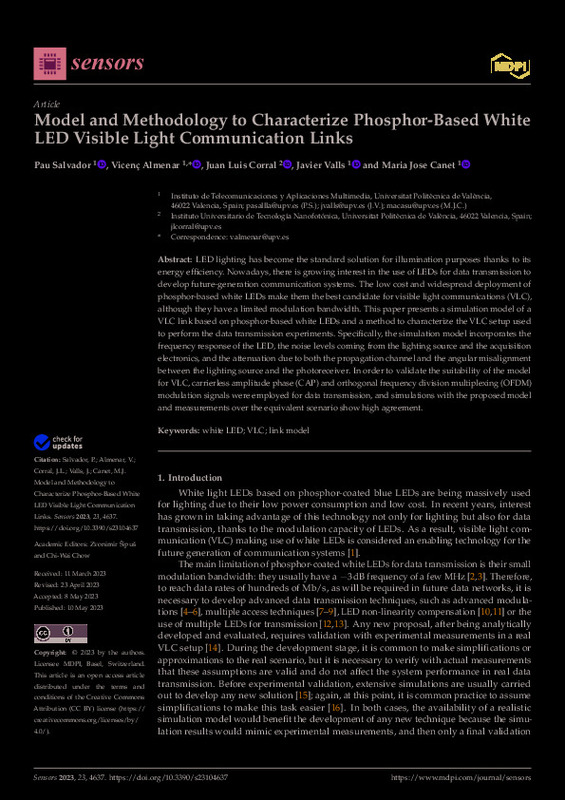JavaScript is disabled for your browser. Some features of this site may not work without it.
Buscar en RiuNet
Listar
Mi cuenta
Estadísticas
Ayuda RiuNet
Admin. UPV
Model and Methodology to Characterize Phosphor-Based White LED Visible Light Communication Links
Mostrar el registro sencillo del ítem
Ficheros en el ítem
| dc.contributor.author | Salvador-Llàcer, Pau
|
es_ES |
| dc.contributor.author | Almenar Terre, Vicenç
|
es_ES |
| dc.contributor.author | Corral, Juan L.
|
es_ES |
| dc.contributor.author | Valls Coquillat, Javier
|
es_ES |
| dc.contributor.author | Canet Subiela, Mª José
|
es_ES |
| dc.date.accessioned | 2024-02-21T19:01:16Z | |
| dc.date.available | 2024-02-21T19:01:16Z | |
| dc.date.issued | 2023-05-10 | es_ES |
| dc.identifier.uri | http://hdl.handle.net/10251/202739 | |
| dc.description.abstract | [EN] LED lighting has become the standard solution for illumination purposes thanks to its energy efficiency. Nowadays, there is growing interest in the use of LEDs for data transmission to develop future-generation communication systems. The low cost and widespread deployment of phosphor-based white LEDs make them the best candidate for visible light communications (VLC), although they have a limited modulation bandwidth. This paper presents a simulation model of a VLC link based on phosphor-based white LEDs and a method to characterize the VLC setup used to perform the data transmission experiments. Specifically, the simulation model incorporates the frequency response of the LED, the noise levels coming from the lighting source and the acquisition electronics, and the attenuation due to both the propagation channel and the angular misalignment between the lighting source and the photoreceiver. In order to validate the suitability of the model for VLC, carrierless amplitude phase (CAP) and orthogonal frequency division multiplexing (OFDM) modulation signals were employed for data transmission, and simulations with the proposed model and measurements over the equivalent scenario show high agreement. | es_ES |
| dc.description.sponsorship | This research was funded by MCIN/AEI/10.13039/501100011033; by the European Union's "ERDF A way of making Europe" grant numbers PID2021-126514OB-I00 and RTI2018-101296-B-I00; and by the Ministerio de Ciencia, Innovacion y Universidades para la Formacion de Profesorado Universitario, grant number FPU19/04648. | es_ES |
| dc.language | Inglés | es_ES |
| dc.publisher | MDPI AG | es_ES |
| dc.relation.ispartof | Sensors | es_ES |
| dc.rights | Reconocimiento (by) | es_ES |
| dc.subject | White LED | es_ES |
| dc.subject | VLC | es_ES |
| dc.subject | Link model | es_ES |
| dc.subject.classification | TEORÍA DE LA SEÑAL Y COMUNICACIONES | es_ES |
| dc.subject.classification | TECNOLOGIA ELECTRONICA | es_ES |
| dc.title | Model and Methodology to Characterize Phosphor-Based White LED Visible Light Communication Links | es_ES |
| dc.type | Artículo | es_ES |
| dc.identifier.doi | 10.3390/s23104637 | es_ES |
| dc.relation.projectID | info:eu-repo/grantAgreement/AEI/Plan Estatal de Investigación Científica y Técnica y de Innovación 2017-2020/RTI2018-101296-B-I00/ES/CONFORMADOR DE HAZ FOTONICO BASADO EN FIBRA OPTICA MULTI-NUCLEO PARA REDES CELULARES BEYOND-5G/ | es_ES |
| dc.relation.projectID | info:eu-repo/grantAgreement/AEI/Plan Estatal de Investigación Científica y Técnica y de Innovación 2021-2023/PID2021-126514OB-I00/ES/TECNOLOGIAS OPTICAS SOSTENIBLES PARA COMUNICACIONES DE ACCESO CON ONDAS MILIMETRICAS Y LUZ VISIBLE EN REDES 6G/ | es_ES |
| dc.relation.projectID | info:eu-repo/grantAgreement/ //FPU19%2F04648//AYUDA PREDOCTORAL FPU-SALVADOR LLACER. PROYECTO: DISEÑO DE UNA RED HÍBRIDA POF-VLC EN ENTORNOS INTERIORES/ | es_ES |
| dc.rights.accessRights | Abierto | es_ES |
| dc.contributor.affiliation | Universitat Politècnica de València. Escuela Politécnica Superior de Gandia - Escola Politècnica Superior de Gandia | es_ES |
| dc.contributor.affiliation | Universitat Politècnica de València. Instituto Universitario de Telecomunicación y Aplicaciones Multimedia - Institut Universitari de Telecomunicacions i Aplicacions Multimèdia | es_ES |
| dc.description.bibliographicCitation | Salvador-Llàcer, P.; Almenar Terre, V.; Corral, JL.; Valls Coquillat, J.; Canet Subiela, MJ. (2023). Model and Methodology to Characterize Phosphor-Based White LED Visible Light Communication Links. Sensors. 23(10). https://doi.org/10.3390/s23104637 | es_ES |
| dc.description.accrualMethod | S | es_ES |
| dc.relation.publisherversion | https://doi.org/10.3390/s23104637 | es_ES |
| dc.type.version | info:eu-repo/semantics/publishedVersion | es_ES |
| dc.description.volume | 23 | es_ES |
| dc.description.issue | 10 | es_ES |
| dc.identifier.eissn | 1424-8220 | es_ES |
| dc.identifier.pmid | 37430551 | es_ES |
| dc.identifier.pmcid | PMC10222683 | es_ES |
| dc.relation.pasarela | S\496987 | es_ES |
| dc.contributor.funder | AGENCIA ESTATAL DE INVESTIGACION | es_ES |
| dc.contributor.funder | Agencia Estatal de Investigación | es_ES |
| dc.contributor.funder | MINISTERIO DE UNIVERSIDADES E INVESTIGACION | es_ES |








